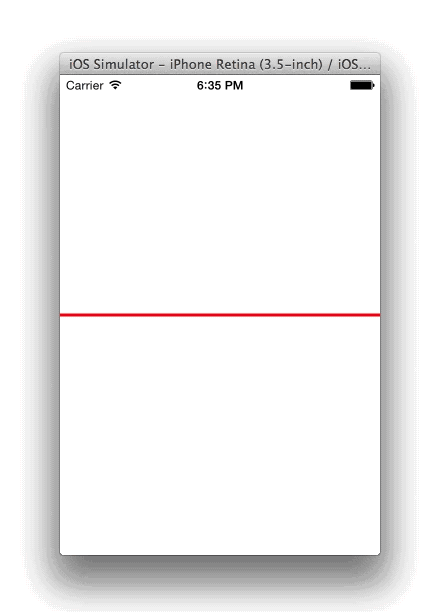IOS: преобразование анимации из линии в кривую Безье
Я хотел бы анимировать прямую линию, изогнутую в кривую Безье (от "_" до "n"), есть ли где-нибудь библиотека, которая может помочь мне сделать это?
Я знаю, как нарисовать кривую Безье с помощью UIBezierPath, я мог бы быстро и постепенно перерисовать преобразование, но если что-то уже происходит, это было бы здорово:-)
1 ответ
Решение
Я мог бы сделать что-то с CADisplayLink, Например, вы можете сделать это в вашем контроллере вида, используя CAShapeLayerНапример:
#import "ViewController.h"
#import <QuartzCore/QuartzCore.h>
@interface ViewController ()
@property (nonatomic) CFTimeInterval firstTimestamp;
@property (nonatomic, strong) CAShapeLayer *shapeLayer;
@property (nonatomic, strong) CADisplayLink *displayLink;
@property (nonatomic) NSUInteger loopCount;
@end
static CGFloat const kSeconds = 5.0;
@implementation ViewController
- (void)viewDidLoad
{
[super viewDidLoad];
[self addShapeLayer];
[self startDisplayLink];
}
- (void)addShapeLayer
{
self.shapeLayer = [CAShapeLayer layer];
self.shapeLayer.path = [[self pathAtInterval:0.0] CGPath];
self.shapeLayer.fillColor = [[UIColor clearColor] CGColor];
self.shapeLayer.lineWidth = 3.0;
self.shapeLayer.strokeColor = [[UIColor redColor] CGColor];
[self.view.layer addSublayer:self.shapeLayer];
}
- (void)startDisplayLink
{
self.displayLink = [CADisplayLink displayLinkWithTarget:self selector:@selector(handleDisplayLink:)];
[self.displayLink addToRunLoop:[NSRunLoop currentRunLoop] forMode:NSDefaultRunLoopMode];
}
- (void)stopDisplayLink
{
[self.displayLink invalidate];
self.displayLink = nil;
}
- (void)handleDisplayLink:(CADisplayLink *)displayLink
{
if (!self.firstTimestamp)
self.firstTimestamp = displayLink.timestamp;
self.loopCount++;
NSTimeInterval elapsed = (displayLink.timestamp - self.firstTimestamp);
self.shapeLayer.path = [[self pathAtInterval:elapsed] CGPath];
if (elapsed >= kSeconds)
{
[self stopDisplayLink];
self.shapeLayer.path = [[self pathAtInterval:0] CGPath];
self.statusLabel.text = [NSString stringWithFormat:@"loopCount = %.1f frames/sec", self.loopCount / kSeconds];
}
}
- (UIBezierPath *)pathAtInterval:(NSTimeInterval) interval
{
UIBezierPath *path = [UIBezierPath bezierPath];
[path moveToPoint:CGPointMake(0, self.view.bounds.size.height / 2.0)];
CGFloat fractionOfSecond = interval - floor(interval);
CGFloat yOffset = self.view.bounds.size.height * sin(fractionOfSecond * M_PI * 2.0);
[path addCurveToPoint:CGPointMake(self.view.bounds.size.width, self.view.bounds.size.height / 2.0)
controlPoint1:CGPointMake(self.view.bounds.size.width / 2.0, self.view.bounds.size.height / 2.0 - yOffset)
controlPoint2:CGPointMake(self.view.bounds.size.width / 2.0, self.view.bounds.size.height / 2.0 + yOffset)];
return path;
}
@end

В качестве альтернативы, если вы хотите сделать это путем создания подклассов UIView, вы можете сделать это так:
#import "View.h"
#import <QuartzCore/QuartzCore.h>
@interface View ()
@property (nonatomic, strong) CADisplayLink *displayLink;
@property (nonatomic) CFTimeInterval firstTimestamp;
@property (nonatomic) CFTimeInterval displayLinkTimestamp;
@property (nonatomic) NSUInteger loopCount;
@end
static CGFloat const kSeconds = 5.25;
@implementation View
- (id)initWithCoder:(NSCoder *)aDecoder
{
self = [super initWithCoder:aDecoder];
if (self) {
[self startDisplayLink];
}
return self;
}
- (void)startDisplayLink
{
_displayLink = [CADisplayLink displayLinkWithTarget:self selector:@selector(handleDisplayLink:)];
[_displayLink addToRunLoop:[NSRunLoop currentRunLoop] forMode:NSDefaultRunLoopMode];
}
- (void)stopDisplayLink
{
[self.displayLink invalidate];
self.displayLink = nil;
}
- (void)handleDisplayLink:(CADisplayLink *)displayLink
{
if (!self.firstTimestamp)
self.firstTimestamp = displayLink.timestamp;
self.displayLinkTimestamp = displayLink.timestamp;
self.loopCount++;
[self setNeedsDisplayInRect:self.bounds];
NSTimeInterval elapsed = (displayLink.timestamp - self.firstTimestamp);
if (elapsed >= kSeconds)
{
[self stopDisplayLink];
self.displayLinkTimestamp = self.firstTimestamp + kSeconds;
[self setNeedsDisplayInRect:self.bounds];
self.statusLabel.text = [NSString stringWithFormat:@"loopCount = %.1f frames/sec", self.loopCount / kSeconds];
}
}
- (UIBezierPath *)pathAtInterval:(NSTimeInterval) interval
{
UIBezierPath *path = [UIBezierPath bezierPath];
[path moveToPoint:CGPointMake(0, self.bounds.size.height / 2.0)];
CGFloat fractionOfSecond = interval - floor(interval);
CGFloat yOffset = self.bounds.size.height * sin(fractionOfSecond * M_PI * 2.0);
[path addCurveToPoint:CGPointMake(self.bounds.size.width, self.bounds.size.height / 2.0)
controlPoint1:CGPointMake(self.bounds.size.width / 2.0, self.bounds.size.height / 2.0 - yOffset)
controlPoint2:CGPointMake(self.bounds.size.width / 2.0, self.bounds.size.height / 2.0 + yOffset)];
return path;
}
- (void)drawRect:(CGRect)rect
{
NSTimeInterval elapsed = (self.displayLinkTimestamp - self.firstTimestamp);
UIBezierPath *path = [self pathAtInterval:elapsed];
[[UIColor redColor] setStroke];
path.lineWidth = 3.0;
[path stroke];
}
@end
Я тестирую оба подкласса UIView а также контроллер представления, и они оба дали примерно 60 кадров в секунду.